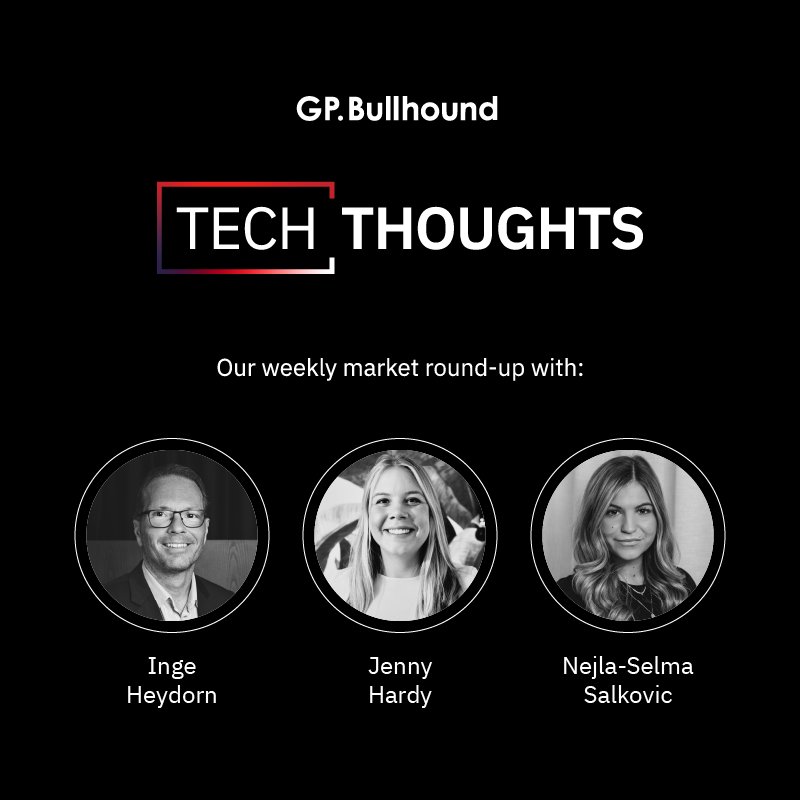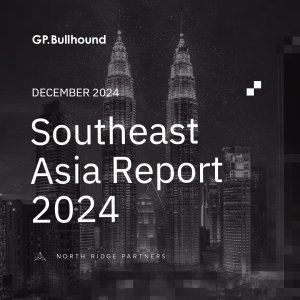Tech Thoughts Newsletter – 13 October 2023.

Market: The Fed, rates and inflation are back in focus towards the end of the week, and weaker Chinese inflation data out today suggests there’s still little tangible recovery there. Some early results rolling in. For our portfolio companies, earnings kick off in earnest next week, so the last week of wait-and-see.
Portfolio: We made no major changes to the portfolio this week.
More US/China noise
- On Friday, the US Commerce Department added 42 Chinese companies to the Entity list.
- The Entity list grew significantly under the Trump administration – most significantly Huawei was added to it in 2019, and SMIC in 2020. It means any US supplier has to obtain licences to export goods to them.
- Supposedly the 42 companies are supplying US tech (specifically US integrated circuits) to the Russian military.
- It continues the US and China tension, with Beijing commenting it was “a typical act of economic coercion and unilateral bullying” from the US.
- More positively, the US will now allow Samsung and Hynix to get semicap equipment into their China fabs, effectively giving them a waiver on the Chinese leading edge restrictions. It means that they will be able to receive US Wafer fab equipment, spare parts and servicing and software, without any need to apply for special licences.
- It’s worth noting that this still doesn’t allow them to receive EUV machines (where there is a de facto ban) – the workaround is for Samsung and Hynix to perform the EUV layer back in Korea – not straightforward given the risks associated with chip transportation (breakages/failures/contamination). For that reason, Samsung and Hynix are likely to continue to diversify their manufacturing footprint away from China.
- TSMC is also said to have received a waiver for its China activities, though is supposedly prevented from any significant technological advancement (presumably any node upgrades).
Portfolio view: There’s no real impact of the new 42 company restrictions – the relevant Chinese semiconductor companies of scale are SMIC and Huawei, and both have been added to the Entity list for some time. More negative is probably the ongoing rhetoric coming from both the US and China about each other. The Hynix/Samsung news is a positive – though we suspect this is more about the US/Korea relationship than any let-up on China restrictions. This means that our thesis of memory spend recovery is on, and indeed there continues to be a tailwind of geographic diversification from China in this area too (Samsung is building up a fab structure in Korea for its P4 line).
Semicap orders recovering and Samsung 2nm news
- VAT Group, which sells valves into the memory tools space, preannounced its Q3 results, slightly ahead of its midpoint guide. VAT has been particularly hurt by the lower memory spend this year – and orders have been hit hard, Q3 was down 48% yr/yr.
- Sequentially though, there are more positive signs – orders are up 5.4% vs Q2, which follows sequential growth on Q1, helped by both a lower level of cancellations and increased new order activity, with Q4 orders expected to be +2% qtr/qtr.
- Importantly, the firm commentary from management is that the “market bottom has been reached”.
- Elsewhere in semicap land, Samsung reportedly could skip 3nm mass production and move straight to 2nm, with potential equipment installation in Q2 2024 and mass production in Q4 2025. Samsung was the first to announce 3nm but is nowhere vs TSMC. We’re not exactly sure that skipping, when its yields in 3nm are still quite low, makes a lot of sense, but it could still happen. Samsung is using Gate All Around (GAA) technology already at 3nm, which TSMC will also adopt at 2nm. So the hope for them is that there is some advantage in learning that Samsung can leverage to try to move closer to TSMC at 2nm.
Portfolio view: We don’t own VAT but we are exposed to the semicap equipment space with positions in ASML, Applied Materials, LAM Research and KLA). Expectations for spend have come down significantly this year and we continue to think orders will hold up better than the market expects, and indeed this quarter we might start to see some early signs of AI-related HBM demand feeding into order books.
The node leadership race between TSMC and Samsung (and indeed Intel) will continue to drive semicap equipment and continue to be a feature of our positive view of the sector.
Nvidia’s B100 – the next big thing
- Nvidia’s latest Investor Presentation is out and features its upcoming B100 “Blackwell” chip, likely launched in 2024, on TSMC’s 3nm and the H200 chip which is likely to be on the current TSMC 5nm node.
- The B100 timeline is accelerated, perhaps because of competition that’s emerging from the likes of Google and AMD.
- It also raises the question of how big TSMC’s 3nm node might be, and what that might mean for capex (and importantly for us semicap equipment).
- Related to AMD’s competition with Nvidia, this week, AMD announced its acquisition of Nod.AI, an AI software startup which specialises in AI model optimisations and reinforcement learning and was also out talking positively about the performance of its MI300 chip (the most obvious alternative to Nvidia).
- There was also a news article last Friday which reported that Microsoft plans to debut an AI chip at its developers’ conference next month, designed specifically for data centre servers that train and run LLMs. It will be an ASIC (Application-specific integrated circuit) and not a GPU and is something we’ll be watching closely. It’s unlikely that it will be released (to third parties at least) in the near term, but it could take some specific workloads for Microsoft and OpenAI away from Nvidia.
Portfolio view: We think there are lots of reasons why Nvidia, which for now is by far the biggest supplier of GPUs, will remain the leader. Its long-term competitive moats around CUDA and its networking advantages mean that we expect it to maintain its dominance, particularly around training infrastructure.
However, we do expect there to be more winners broadly in AI, given no player will want to be entirely tied into one very dominant supplier in Nvidia (AMD is the most obvious for us with its MI300 product – and we own both Nvidia and AMD). We think that the hyperscalers too, will be motivated to build their chips – given they have enough utilisation, a big enough user installed base, and specific use cases: Google is the most obviously progressed here with its TPU v4, but for Microsoft, the same motivations exist.
How quickly Nvidia can and will move its products to 3nm and what that might mean for TSMC’s short-term capex trajectory is important (for both TSMC and semicap) – we might hear more on that at TSMC’s results next week.
Samsung reports better numbers – memory cycle turning
- Samsung reported its preliminary Q3 numbers this week – which were “bad but better”.
- Its Q3 operating profits were down 78% yr/yr (but Q2 was down 95%). Q3 sales were up 12% sequentially.
- While we don’t have the divisional details until next week, it’s very likely driven by memory ASP improvement (we think DRAM ASPs were up ~5% qtr/qtr in Q3 and will likely be up another double-digit % qtr/qtr in Q4.
- This has been one of the most brutal memory downturns of the last decade but the numbers suggest we are now coming out of the other side.
Portfolio view: We don’t invest in memory players – while we do believe that the build-out of generative AI infrastructure will result in meaningful bit growth for the memory industry as a result of the DRAM content growth per server (and increased technical features around bandwidth and transfer rates – Samsung will launch its latest HBM4 in 2025), the reality is that the industry relies on rational supply. While Hynix and Samsung both spent their conference calls arguing for tech leadership in DRAM, ultimately the 3 players have always ended up with broadly the same tech, which means that rational supply can very easily break down, and has always struggled to make a sustainable return – just as we’ve seen over the past several quarters in the industry with the negative impact on pricing.
We do think we should benefit from any memory recovery and the related bit growth through our semicap equipment exposure – any stabilisation in DRAM ASPs is positive – and areas like HBM require new higher-end process tools given the increased technical requirements.
China’s smartphone share data
- We’re starting to see early smartphone sales data in China after the Huawei Mate 60 Pro release.
- According to a local data vendor, and posted on the social media/blog site Weibo, the Mate Pro has passed 1 million weekly sales – which would mean that yields on its 7nm chip might not be as low as observers had assumed (or hoped for).
- That would put it at 17% share, vs Apple’s 19% – and likely to overtake quite quickly.
Portfolio view: We’ve commented before that Apple (which we own) looks vulnerable to market share loss to Huawei. Huawei used to have a 16% smartphone market share in China, which declined to ~2% by 2022 (after the US blacklist). We continue to watch it closely.
More Taiwanese September numbers
- Mediatek reported September sales down 15% mth/mth and down 36% yr/yr. It brought Q3 revenue to NT$110bn, up 12% qtr/qtr, down 23% yr/yr and beating the high end of its guidance of up 11% qtr/qtr.
- Those aren’t stellar numbers by any means but with Android smartphone restocking expected to continue in the near term, it means Q4 should show sequential growth again, which will put Q2 as the firm trough.
- Sunny Optical also reported its September shipment, with its main smartphone HCM (camera) and HLS (lens) business growing 41% yr/yr and 17% yr/yr respectively. Sunny is benefiting from the iPhone launch as well as Huawei (and more broadly Android market stabilisation). We commented last week that the camera continues to be a standout feature in the smartphone market.
- All our data points from Taiwan so far (we spoke to TSMC, UMC, Hon Hai and Largan last week too) rhyme true with a better Taiwanese export number for September too – it rose for the first time in 13 months (+3.4%). It’s an important data point given Taiwan’s so central to the semis supply chain and, in particular the leading edge, which is now tied up in AI and GPU demand.
- In the details, exports for “Information, Communication and Audio-video Products” rose a massive 60% to the second highest ever absolute dollar number; and exports to the US (which is probably the biggest receiver of AI chips via Nvidia, Google and Broadcom) grew 18% yr/yr from 9% in August.
Portfolio view: All the data we’re seeing point to certainly stabilisation, and maybe a recovery in global semis markets.
PC Market bottoming but deteriorating pricing risk
- HP Inc. reported results and issued guidance for FY24 which indicated the PC segment should be improving into next year, helped with a refresh cycle, but we think still held back by a deteriorating pricing environment.
- Acer’s Q3 numbers too, reflected a PC market bottoming – Q3 revenue was up 16% qtr/qtr and 4% yr/yr.
- UDN reported that semis inventory is now down to a reasonable level and that some customers are starting to restock ahead of holiday demand – the PC market will likely benefit, returning to somewhat more normal seasonality.
- Broadly the better September numbers are consistent with August’s pull-in commentary, and better inventory levels, though there is no real conviction in end demand returning. That contributes to our view that pricing will likely come down to try to stimulate demand.
Portfolio view: The PC market is still not a market we want to be exposed to – as we’ve commented before on smartphones, units can improve but the PC market is still very vulnerable to competitive pricing dynamics.
Adobe Max – AI and ARPU uplift
- Another analyst day and of course more AI – this time Adobe (owned) which was probably one of the first software businesses to integrate AI into its software product in a very obvious way – with its Firefly Image Generation product.
- Maybe the most significant announcement at the event was the launch of its Firefly Image 2 LLM which adds more features to the image generation engine (motion blur, depth of field, field of view adjustments, Generative Match which restyles images to an existing brand).
- The CEO noted that Firefly has generated 3 billion images, 50% more than just a month ago, which speaks to the strong initial momentum and adoption by users.
- Adobe has also been very explicit about pricing for its AI products which will largely be consumption/credit-based.
- At its results last month it announced the standalone pricing of Firefly, which will be included in the broader creative suite alongside a 6-10% price increase across its Creative Cloud plans. It will also be priced at $4.99 a month as a standalone freemium model (consumer-type pricing to drive mass market adoption) – which gives you access to 100 credits per month (we think 1 credit is broadly 1 text-to-image/image effect.
Portfolio view: The question for us in software and AI has been when and if AI starts to be a meaningful revenue generator for software companies, rather than the current cost of doing business. Adobe’s monetisation plan is helpful in that it starts to answer that question. It’s well positioned both from a scale of investment and from a product set perspective (with an ability to leverage AI tools across a broad product suite). The key for us in the portfolio is those businesses that can generate a meaningful and sustainable return on invested capital from those AI investments.
Enterprise spend still experiencing headwinds
- We had Accenture report slightly damp results a couple of weeks ago and this week the Indian IT Services companies (TCS, HCL and Infosys all reported) followed with some weaker results across the board.
- TCS Q2 was weak – revenues +3% yr/yr and flattish qtr/qtr, Infosys Q2 revenues were +3% yr/yr, HCL was also +3% yr/y, though was probably the most solid overall.
- All management commentary indicated some challenges on deal volume, weaker discretionary spend, and an uncertain outlook in the near term – Infosys tweaked down the upper end of its guidance range.
- Headcount is now declining – ~5% yr/yr, which in itself means growth in 2024 looks hard to achieve, though all were reporting solid margins.
Portfolio view: The IT services companies are late-cycle businesses rolling over (after two years of double-digit growth) – and while they are well-managed businesses, compounding earnings through consistent margin leverage, we think there are better opportunities elsewhere in tech right now.
Finally, news this morning that the UK has approved Microsoft’s acquisition of Activision, which means the deal is now expected to close
- In August, Microsoft announced that it would give Ubisoft the cloud streaming rights for all of Activision Blizzard’s existing PC and console games and new games released during the next 15 years as part of Microsoft’s efforts to placate the UK and US regulators.
- For us it was surprising – we had thought that Microsoft would sell the UK cloud gaming rights but not worldwide. It means that Microsoft will not be able to release Activision titles exclusively on its cloud streaming service.
- While we had always said it made no sense for Microsoft to stop selling games on other console platforms, we had assumed it might want to keep exclusivity on its own Xbox Game Pass subscription service. This will now clearly not be the case, with Ubisoft able to include Call of Duty within Ubisoft+ or indeed any cloud service with a subscription business model.
- Technically, we assume if it wanted to Ubisoft could only offer Activision titles on its subscription model, but for the same reason Microsoft would always have made titles available on a pay-per-title basis to other platforms, it would make no financial sense for Ubisoft not to make Activision titles available to every subscription service.
- The deal does still make sense for Microsoft, in that Activision games will be made available for a streaming subscription service, whereas Activision as an independent entity would not, and so in that sense, it does make a streaming service (GamePass) that includes Activision games more compelling than without, but it does also open up Game Pass to more compelling competition.
- So no surprise that the deal has now been passed – that has largely been expected since these measures were announced in August.
Portfolio view: We own Microsoft, though the gaming business remains a small part of the overall, and the outcome of the case isn’t a factor in our thesis. We think cloud gaming as an alternative (effectively subscription) business model is interesting though – and it could well be Microsoft’s opportunity to build a big consumer business (which again, it has failed to do with Xbox). And to the extent of the deal going ahead means that Activision titles will be available via subscription making this an increasingly viable business model in gaming.

For enquiries, please contact:
Inge Heydorn, Partner, at inge.heydorn@gpbullhound.com
Jenny Hardy, Portfolio Manager, at jenny.hardy@gpbullhound.com
Nejla-Selma Salkovic, Analyst, at nejla-selma.salkovic@gpbullhound.com
About GP Bullhound
GP Bullhound is a leading technology advisory and investment firm, providing transaction advice and capital to the world’s best entrepreneurs and founders. Founded in 1999 in London and Menlo Park, the firm today has 14 offices spanning Europe, the US and Asia.



